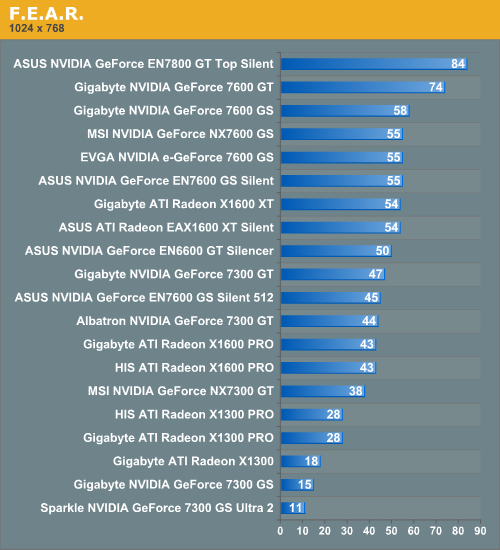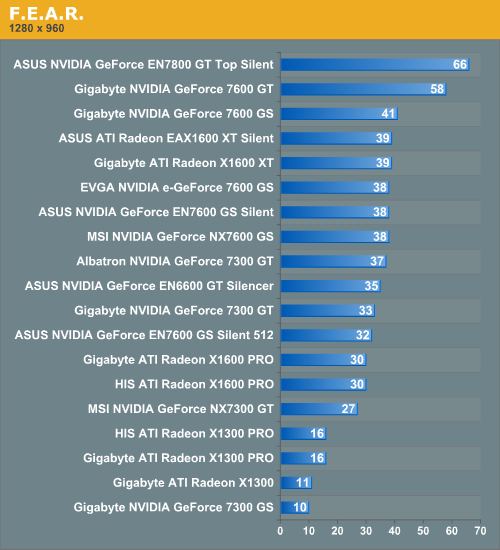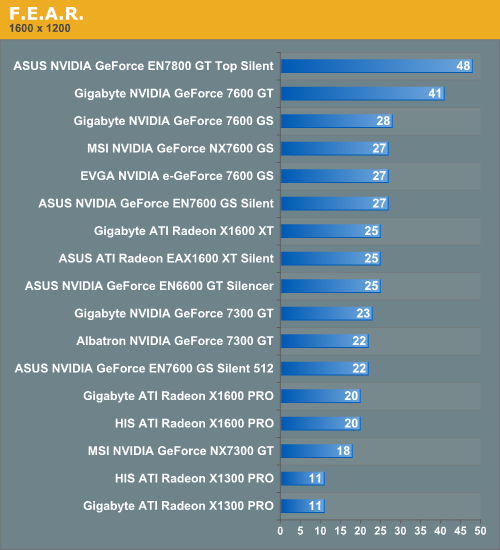F.E.A.R.
F.E.A.R has its own built in benchmark that consists of a fly-through of different game elements such as a firefight between soldiers, an explosion with fire, and hovering over rippling water. We tested the cards with most of the high end settings enabled, turning off soft shadows as we have in the past. We've found that the performance cost of soft shadows isn't worth considering, no matter what card is used, given how poor this effect looks in this game.
As with all the games, we again tested without antialiasing and with filtering set to "trilinear." Since this is another somewhat fast-paced first-person shooter, we consider an average of no less than 25 fps to be acceptable for playable performance.




This is another game that seems to favor ATI hardware a bit more than NVIDIA. We again see the Sparkle 7300 GS Ultra 2 at the bottom of the list, and it's not really playable at 800x600, as in Rise of Legends. The Gigabyte X1300 manages to pull off a playable framerate of 29 fps at this resolution. The Gigabyte and HIS X1600 Pro cards do very well up to 1280x1024, and for those who don't mind being limited to 1024x768 the X1300 Pro offerings from the same companies will run this game fairly well. The emerging theme in this article, however, is that the 7600 GS performs better than either of these cards (more or less depending on the game) and it's hard for ATI to compete with the value of the Gigabyte 7600 GS given current prices.
F.E.A.R has its own built in benchmark that consists of a fly-through of different game elements such as a firefight between soldiers, an explosion with fire, and hovering over rippling water. We tested the cards with most of the high end settings enabled, turning off soft shadows as we have in the past. We've found that the performance cost of soft shadows isn't worth considering, no matter what card is used, given how poor this effect looks in this game.
As with all the games, we again tested without antialiasing and with filtering set to "trilinear." Since this is another somewhat fast-paced first-person shooter, we consider an average of no less than 25 fps to be acceptable for playable performance.




This is another game that seems to favor ATI hardware a bit more than NVIDIA. We again see the Sparkle 7300 GS Ultra 2 at the bottom of the list, and it's not really playable at 800x600, as in Rise of Legends. The Gigabyte X1300 manages to pull off a playable framerate of 29 fps at this resolution. The Gigabyte and HIS X1600 Pro cards do very well up to 1280x1024, and for those who don't mind being limited to 1024x768 the X1300 Pro offerings from the same companies will run this game fairly well. The emerging theme in this article, however, is that the 7600 GS performs better than either of these cards (more or less depending on the game) and it's hard for ATI to compete with the value of the Gigabyte 7600 GS given current prices.










49 Comments
View All Comments
imaheadcase - Thursday, August 31, 2006 - link
I guess to each his own, i play bf2 on a 19inch CRT monitor at 1024x768. But even if i had a better card i would still prefer lower rez.DerekWilson - Thursday, August 31, 2006 - link
it's an issue of how games work on the inside ...all the objects, shapes, characters, and landscapes are there no matter how you see them. everything is mathematically represented in the software. rendered onto your display is a viewport into the world. this viewport only allows you to see a fixed grid of colors. the color of each pixel is determined by a bunch of factors, but the largest contribution is made by the object that projects onto a particular pixel.
... on second thought, this is too hard for me to explain with out a lot of math. lets look at it another way.
when there's a naked person on tv, they decrease the resolution of the area over the persons naughty bits. this makes it harder to see what's really there because there is a smaller number of large pixels that can only represent one color each. it follows, then, that it would also be harder to shoot the person acurately in said bits.
I think your preference may be based on your experience with performance at higher resolutions. Responsiveness is necessary for a quality experience in games like bf2. If you get a faster card, I would encourage you to at least try a higher resolution.
blckgrffn - Thursday, August 31, 2006 - link
When it is in stock at newegg, its ~$90, not nearly $140.Nat
mostlyprudent - Thursday, August 31, 2006 - link
I would be interested to know how much noise (quantitatively) an actively cooled 7600GS or 7600GT contributes to a system built in a relatively quiet case like an Antec P150. I am familiar with some of the leaf blowers attached to the higher end cards, but wonder how much overall system noise savings you'ld get in the mid-range cards.wilburpan - Thursday, August 31, 2006 - link
One obvious use for silent video cards would be in an HTPC system, where quiet performance would be a priority. Can't have those noisy computer fans intrude on watching Snakes on a Plane, you know. :@) Anyway, it would have been nice to include some video playback benchmarks to see how these cards can handle playing back a 1080p HDTV signal, or similiar tests.ViRGE - Thursday, August 31, 2006 - link
Since HDTV is MPEG2, any modern video card should be able to handle a 1080P signal(since this is an either/or case, it either can or can't). The limitations come in to H.264, where the video decode engine may not be clocked high enough to do higher resolution decoding. Unfortunately, I'm not sure there's any 1080 commerical/usable content that would work with Cyberlink/Intervideo's H.264 decoders(the only ones with GPU acceleration), since Quicktime content doesn't work in those.DerekWilson - Thursday, August 31, 2006 - link
with nvidia, the video decode engine is clocked off the core -- it actually will run better on a card with fewer pipelines and a higher core speed ... iow, the 7600gt is a better video decode graphics card than a 7900gt at default clock speeds.a little counter intuitive, but there it is.
nvidia 7 series parts with a core clock of >450 MHz should have no problem accelerating 1080p decode on players that support purevideo.
MontagGG - Thursday, August 31, 2006 - link
Which of these have HDCP?DerekWilson - Thursday, August 31, 2006 - link
to my knowledge, none of the cards tested here support hdcp. but I will certainly try to confirm this ...